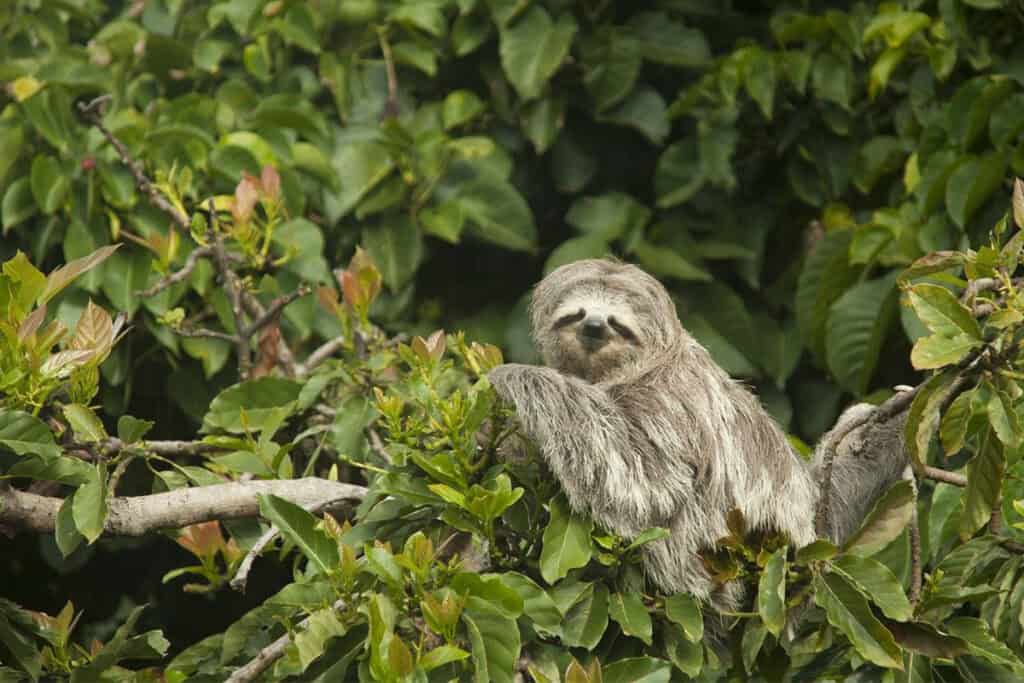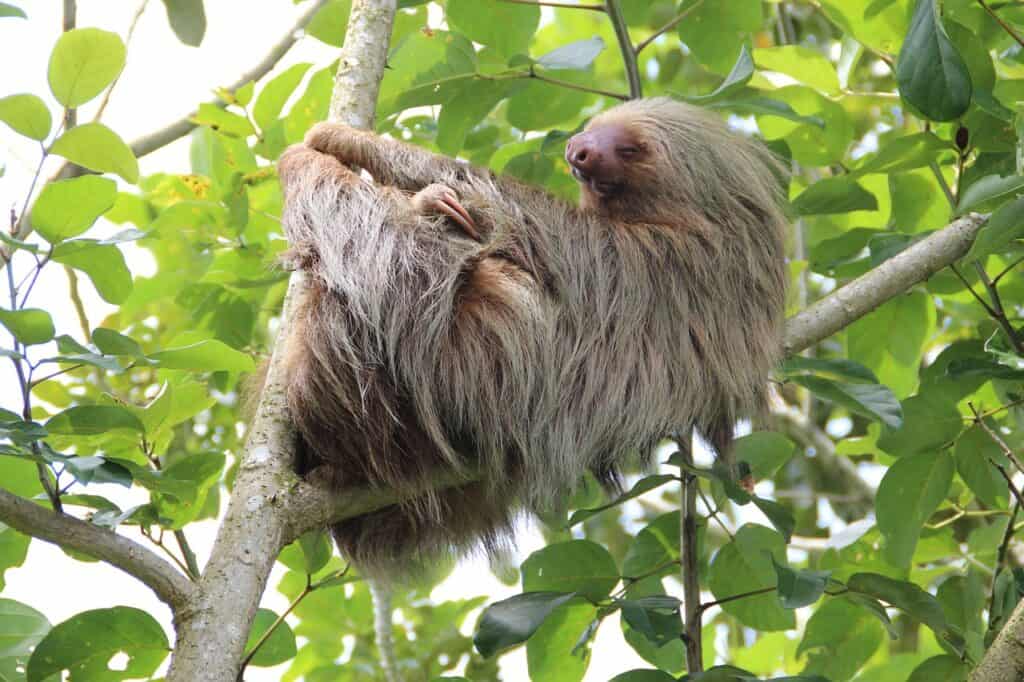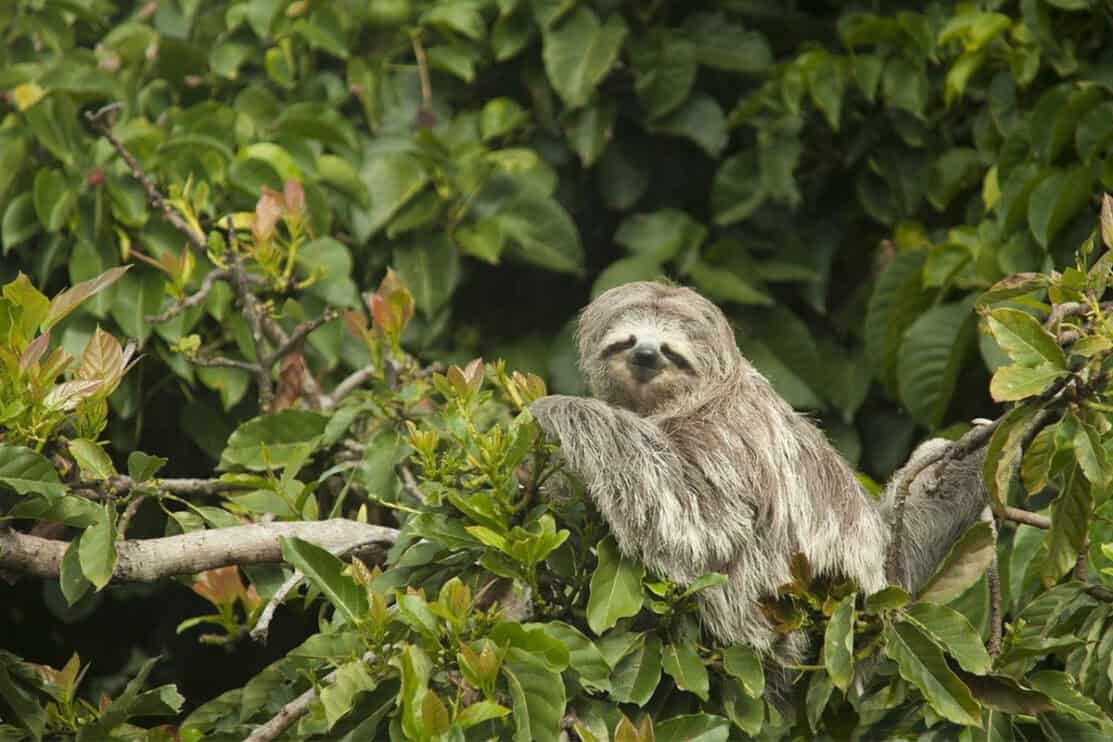
Ever wondered where to find sloths in Costa Rica? This country is famous for its rich wildlife, including two sloth species: the Hoffmann’s two-toed and the Brown-throated sloth. With its vast rainforests and 800 miles of coastline, it’s a perfect home for these animals. But, spotting them can be hard because they blend in so well.
This guide shows you the top spots to see sloths in Costa Rica. You’ll have a good chance of seeing these animals in places like Manuel Antonio National Park and Tortuguero. These spots offer great views of sloths in their natural setting.
What Makes Costa Rica a Sloth Paradise
Costa Rica is a haven for sloths thanks to its vast rainforests and thriving ecosystems. These places are perfect for sloths to live. The country values eco-tourism, which helps protect wildlife in their natural homes. The Sloth Conservation Foundation says sloths do well here because they have plenty of food, like leaves from Cecropia trees.
In this area, two sloth species live in the treetops: the brown-throated three-fingered sloth and the Hoffmann’s two-fingered sloth. Each has its own special features, like the three-fingered sloth’s long arms and the two-fingered sloth’s big pig-like nose. Eco-tourism lets visitors see these amazing animals in the wild. It also helps spread the word about saving them.
But, sloths are facing threats from deforestation and climate change. Costa Rica is working hard to keep its forests safe, covering 52% of the country with them, including many national parks. This is crucial for sloths to survive. Efforts to reduce human impact and create wildlife corridors help make the environment better for sloths.
Types of Sloths in Costa Rica
Costa Rica is home to two main sloth species: the Hoffmann’s two-toed sloth and the Brown-throated sloth. Each has its own special traits that make them stand out. The Hoffmann’s two-toed sloth is mostly active at night, so seeing them is a rare joy. On the other hand, the Brown-throated sloth is active during the day, making it easier to spot.
Both sloth species live in the treetops, where they fit right in. They move slowly to save energy, which is quite interesting. Sloths digest food very slowly, taking up to two weeks to finish a meal. They mainly eat leaves and buds, especially from the Cecropia tree.
Sloths spend most of their time in trees, only coming down to the ground to poop, which they do once a week. While they’re not endangered, they face threats from predators like wildcats and Harpy Eagles. Seeing these gentle sloths in the wild is a special experience. Knowing the difference between the Hoffmann’s two-toed and Brown-throated sloths makes wildlife watching even better. It shows how important it is to respect their homes and not disturb them.
1. Manuel Antonio National Park: A Prime Spot for Sloth Viewing
Manuel Antonio National Park is a top spot for seeing sloths along Costa Rica’s Pacific coast. It’s famous for its rich wildlife and lush rainforests. These forests are perfect for sloths like Hoffmann’s and Brown-throated sloths. The park has easy-to-follow trails, letting visitors enjoy the beautiful views.
Guided tours in Manuel Antonio National Park are great for spotting sloths. Experts lead these tours, helping visitors see sloths in the treetops. The tours are more exciting with knowledgeable guides and the park’s rich wildlife.
The park is close to beautiful beaches and places to stay, making it perfect for nature lovers. Whether you’re walking the trails or chilling on the beach, you might see sloths. This adds excitement to your visit and shows Costa Rica’s dedication to protecting wildlife.
| Sloth Species | Common Name | Habitat | Activity Pattern |
|---|---|---|---|
| Bradypodidae | Brown-throated Three-toed Sloth | Tropical rainforests | Diurnal |
| Choloepus | Hoffmann’s Two-toed Sloth | Tropical rainforests | Nocturnal |
2. Discovering Sloths in Corcovado National Park

Corcovado National Park is a top spot for sloth fans. It covers 163 square miles on the Osa Peninsula. It’s known for its huge variety of life and different environments. Here, you can see both the three-toed and Hoffman’s two-toed sloths in their natural homes.
Guided tours make visiting the park even better. They help you explore the park’s vastness and its rich wildlife. Sloths live in the park’s green rainforests, often hanging in trees. So, you need to look up to see them. The best times to spot them are early in the morning or late in the afternoon.
Staying overnight lets you really experience the park’s magic. You can enjoy activities like hiking, bird watching, and kayaking. Corcovado National Park is a place that amazes sloth enthusiasts and offers memorable nature adventures.
3. Sloths in Costa Rica: Arenal Volcano Area
The Arenal Volcano area in La Fortuna is a top spot for seeing sloths. It has lush forests full of life, perfect for sloths like the Hoffmann’s two-toed and brown-throated sloths. Eco-tours and nature walks let visitors get close to these amazing animals.
On average, tours here see about eight sloths, with a record of 13 at once. Some tours even show sloths with their babies, which is very special. About 30% of tours find two-toed sloths, which are less common than the brown-throated ones.
Many tours come with snacks or breakfast, making the trip more fun. 60% of tours also focus on birdwatching, along with sloth photography and wildlife watching. Guides are often praised for their skill in finding sloths in the dense foliage.
Visitors might also see howler monkeys or the Jesus Christ lizard on their journey. The peaceful nature around Arenal Volcano makes it a great place for nature lovers and photographers.
4. Cahuita National Park: Caribbean Coast Sloth Habitats
Cahuita National Park is a top spot for seeing Caribbean sloths along Costa Rica’s Caribbean coast. The park’s lush rainforest is perfect for wildlife watching. You can follow self-guided trails, like the 8km flat trail, to see sloths hanging from trees or climbing vines.
Beautiful beaches like Punta Uva and Playa Chiquita offer a peaceful setting for sloth fans. Guided tours in sloth conservation areas boost your chances of seeing these unique animals. You’ll learn about the different ecosystems too. The park is also great for birdwatchers, with over 300 bird species.
You might see tamanduas, monkeys, and many marine creatures in the park. Cahuita National Park is a top spot for observing Caribbean sloths in their natural setting. Snorkeling on the park’s coral reefs is a great way to experience Costa Rica fully.
| Activities | Description | Cost |
|---|---|---|
| Beach Bike Rental | Explore the coastal areas of Puerto Viejo | $6 for 24 hours |
| Kayak Rental | Enjoy the waters near Punta Uva | $10-15 per hour |
| Rafting on Pacuare River | Experience thrilling class III and IV rapids | Approximately $90 per person |
| Snorkeling | Explore marine life with a certified guide | Varies based on tour provider |
5. Exploring Tortuguero National Park for Sloth Sightings
Tortuguero National Park is a top spot for sloth lovers. It’s filled with canals and jungles perfect for sloths. You can take guided tours to see these creatures in their home.
Sloths love to hang in trees, eating and resting a lot. The park is also known for its turtle nesting season from July to October. This is when baby turtles come out, making it a special time to visit.
With over 400 bird species, the park is a haven for wildlife enthusiasts. This makes the tours even more exciting.
The park is open from 6 AM to 4 PM, with a break for lunch. You can take a guided boat tour for 15 USD or rent a canoe for 20 USD a day. There are also organized canoe tours for 40 USD.
Boat tickets from La Pavona to Tortuguero are 20 USD round trip. There are many departures throughout the day.
Sloths are a big draw for visitors. They are cute and calm, making them a must-see on any tour. For the best chance to see them, go on tours with guides who know where to find them.
| Activity | Cost (USD) |
|---|---|
| Guided park tour (non-resident adult) | $15 |
| Canoe rental (per day) | $20 |
| Organized canoe tour | $40 |
| Boat tickets round trip (La Pavona to Tortuguero) | $20 |
BONUS: Monteverde Cloud Forest: A Unique Sloth Experience
The Monteverde Cloud Forest is a place of wonder, full of life and beauty. It’s home to over 90% of untouched rainforests, making it perfect for those who love wildlife. Here, you can see sloths hanging in the trees, blending into the greenery.
Sloths in this forest are mostly active at night. Taking a guided walk at night lets you see them up close. They spend a lot of time in the trees and sleep a lot, up to 18 hours a day.
Helping sloths is important here. The Sloth Sanctuary at Sepulture cares for injured sloths. You can visit and learn why we need to protect these amazing animals. The Sloth Sanctuary at Selvatura Park is another place to see sloths in a safe space, with almost 20 of them.
| Tour Options | Duration | Adult Price | Student Price | Child Price |
|---|---|---|---|---|
| Sloth Sanctuary Tour | 45 minutes | $39 | $35 | $27 |
| Hanging Bridges + Sloth Sanctuary | 3.5 hours | $104 | $93 | $72 |
Family is key for sloths. Baby sloths stay close to their mothers until they can move on their own. This shows how sloths live in the Monteverde Cloud Forest.
Sloths are more than just cute animals. They eat leaves and fruit, helping to spread seeds and grow new plants. Learning about them helps us value nature more in the Monteverde Cloud Forest.
Sloth Viewing Ethics: Responsible Wildlife Tours
Watching sloths is magical, but we must do it right. When taking guided tours, keep a safe distance and don’t touch them. This way, sloths can live happily in their homes, away from us.
In Costa Rica, choose tours that focus on protecting sloths. Pick guides who care about conservation. Remember, sloths sleep a lot in trees and only come down once a week to poop. This shows how important it is to respect their life.
Working together between farmers, tour guides, and locals helps these tours succeed. Don’t go on tours that let you hug or bother the sloths too much. Such actions can stress them out. By watching wildlife responsibly, we can keep these amazing animals safe and enjoy seeing them in their natural world.

